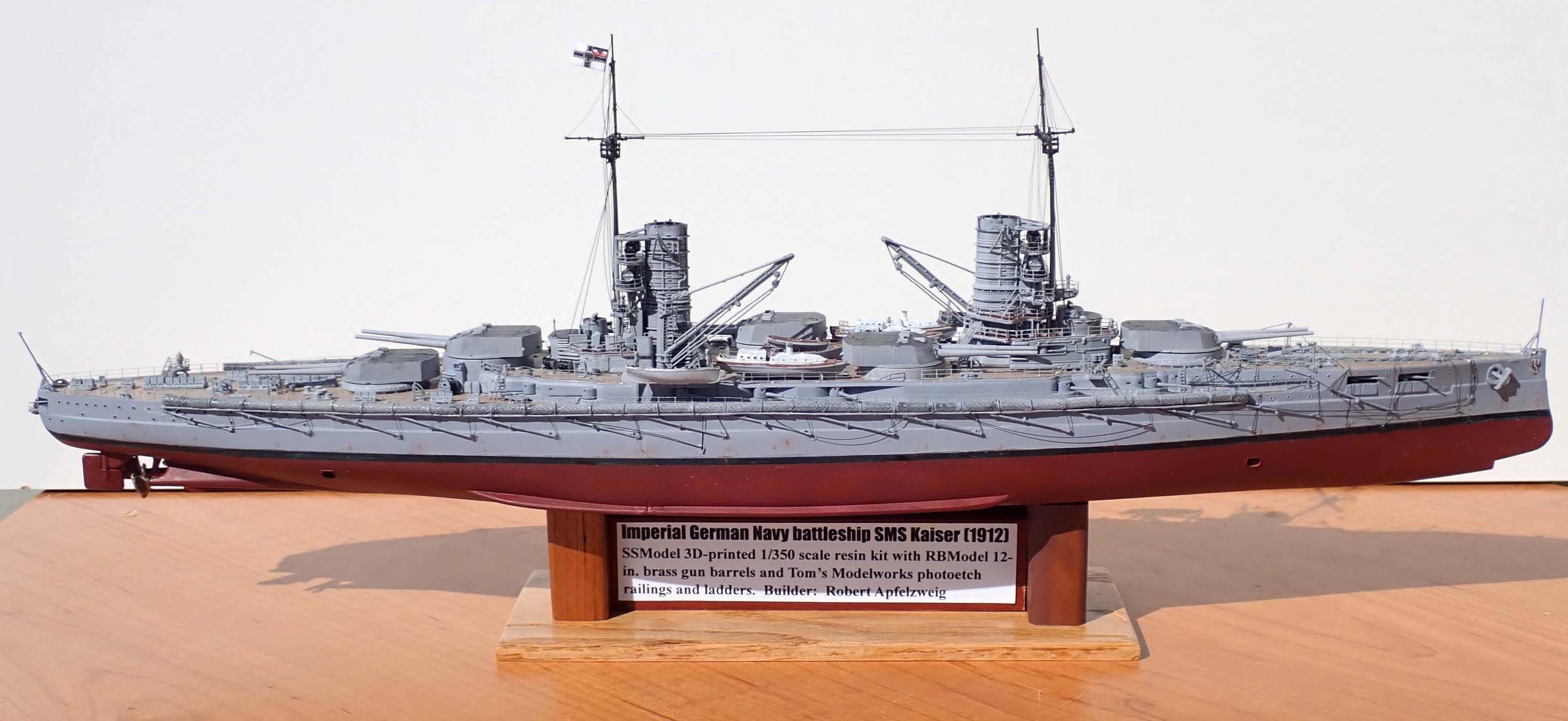
1/350 SMS Kaiser (SSModel)
|
by Robert Apfelzweig |

1/350 SMS Kaiser (SSModel)
The Imperial German Navy battleship SMS Kaiser was the lead ship of a 5-ship class that were Germany’s first battleships to mount a superfiring main gun turret. Commissioned in 1912, the Kaiser fought at Jutland (May 1916), sustaining two hits that caused minor damage, and at several lesser battles before being interned at Scapa Flow with most of the rest of the surviving Imperial German Navy warships in late 1918. Along with nearly all of these interned ships, the Kaiser was scuttled by her skeleton crew on June 21, 1919. The ship was raised from the sea floor ten years later and towed, upside down, with keel and screws displayed, to Rosyth for scrapping, which began a year later.This model of the SMS Kaiser is one of many new offerings from several Chinese companies in 3D-printed kits sold through online auction sites, in this case by SSModel. As with many of these kits, there is little -- or, in this instance, no – documentation or instructional information for assembly. Although most parts, once separated from their casting trees, are easily identifiable, many smaller parts and deck fittings may be unidentified as to what they are or where they are supposed to be attached. The best (so far, of those kits I have purchased) kits have two-part hulls that are very skillfully crafted; this one, however, had its hull in three sections (forward, middle and aft), and breaking off the casting pieces was both tedious and required considerable effort with clippers. Subsequent alignment of these hull sections was rather difficult, and joints were not always even no matter how much I tried to adjust them – much puttying and sanding was needed. As for those smaller and more obscure parts, I resorted to several online color images from the War Thunder gaming website, which may have actually provided the source reference for the design of this kit in the first place. Thus, I was able to position the numerous open skylights, small vents, cable reels and small boats. The cylinders of 5.9-in. casemate guns had barrels that seem to me to be slightly undersized, if accurately shaped, but I had to sand both the top and bottom of the insertion cylinders to get them to fit into the hull’s openings for them. The kit provides what seems to be a full set of 3D-printed railings, but I much preferred photoetch 2-bar railings and ladders from Tom’s Modelworks, which are far more to scale. Similarly, the 3D-printed rolled up anti-torpedo nets didn’t look very convincing, so I used some interwoven shoelaces (something I have done for previous WWI battleship and battlecruiser models) as substitutes. There are a number of high-quality online photos of the SMS Kaiser that provide an adequate rigging guide, and I used stretched black sprue for the rigging. The 3D-printed 12-in. gun barrels seemed a bit undersized, and I replaced them with turned brass barrels from RBModel. A “finishing touch” were the two bow crests, which are decals that I made using an image of the Hohenzollern family crest (Germany’s Imperial family name) and which seemed to be their most likely source. A significant accuracy issue in this kit is the oversized deck planking, but I could do nothing about this. I should point out that this kit arrived at my home from China within three weeks of ordering.
In conclusion, these 3D-printed kits can be made into quite attractive models but one must be patient and thorough in researching their assembly and finished appearance. Even when assembly instructions are included, they tend to be on one sheet of paper in a 2-color format in which the individual parts are barely discernable due to the small size of the imagery. And, although this has not yet been my experience, some of these kits may be entirely unsatisfactory due to quality control issues in their manufacture (e.g., damaged parts, missing parts, and residual liquid resin).
